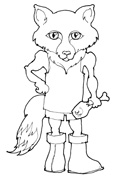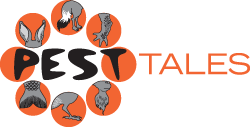Lesson Plan
Unit 2 — PEST INVADERS
Activity — Food for thought
Setting the scene
All plants and animals need food which provides the energy they need to live.
What is a food chain?
A food chain shows how each living thing gets its food within an ecosystem.
The arrows in a food chain show who is eating who.
A food chain always starts with plant life and ends with an animal.
A simple food chain contains:
Producers — producers are usually green plants
Producers are able to use light energy from the sun to make food from carbon dioxide and water. All species in an ecosystem depend on producers.
Consumers — consumers are animals that obtain their food by eating other organisms.
There are three levels of consumers.
- Primary consumer — an animal that feeds on plants or plant products
- Secondary consumer — an animal that feeds on a primary consumer
- Tertiary consumer — an animal that feeds on a secondary consumer
Consumers are also classified by what they eat:
- Herbivore — an animal that eat plants or plant products.
Example: grasshoppers, mice, cows, rabbits and kangaroos. - Carnivore — an animal that eats other animals.
Example: snakes, spiders, cats, cheetahs and eagles. - Omnivore — an animal that eats both plants and other animals.
Example: tortoises, bears, foxes, monkeys and people.
Note: Omnivores can act as primary consumers when eating plants and secondary and tertiary consumers when eating meat.
Each food chain ends with a top predator, an animal with no natural enemies.
Example: a polar bear or crocodile
When any organism dies, it is eventually eaten by scavengers (like vultures, worms and crabs) and broken down by decomposers (mostly bacteria and fungi), and the exchange of energy continues.
Example of a food chain
For a simple food chain using species found in Tasmania refer to the Food chain in Tasmania worksheet.
What happens when your Tasmanian food chain is affected by humans?
People, and the actions they take, can put a food chain in danger.
The clearing of native grasslands for farming can reduce, or remove altogether, the plant food required to sustain healthy populations of Tasmania grasshoppers. The reduction in grasshopper numbers in turn affects the survival of the mountain dragon. Increased habitat pressure for the eastern quoll (already an endangered species) may cause it to disappear from the area altogether.
What happens when a fox is introduced to your Tasmanian food chain?
Competition from a feral animal can cause huge disruption to a food chain.
An introduced predator, such as the fox, can infiltrate quickly into a food chain by:
- consuming endangered species
- causing reproductive pressure on endangered species (when numbers are reduced it can be hard for an endangered animal to find a mate)
- competing for food with other native species such the eastern quoll and Tasmanian devil
- competing with native animals for shelter and sites to rear their young
- spreading disease to native animals
- spreading environmental weeds.
Foxes have a broad diet which includes mammals, birds, reptiles, amphibians, insects, fruits, and berries.
The strength of your Tasmania food chain would be severely tested due to the fox:
- preying on Tasmanian grasshoppers and reducing their numbers
- reducing food for the mountain dragon
- preying on mountain dragons and reducing their numbers
- reducing food for the endangered eastern quoll.
The food chain would become particularly vulnerable when the number of foxes increases due to the lack of diseases and natural enemies. The fox would be positioned as top consumer (an animal which is not eaten by other consumers) which would eventually affect all of the animals and plants within a food chain.

Foxes in Tasmania
An increasing amount of physical evidence indicates that the red fox has recently been introduced into Tasmania. It is not known how many foxes are there or how they got to be in Tasmania but should the species become established all of Tasmania’s native land animals would be at great risk.
Tasmania is recognised as a national fauna haven due to the lack of foxes. A number of native mammals, including the Tasmanian pademelon and Tasmanian bettong, are now extinct on mainland Australia due to the fox. More widespread species like ducks, shorebirds, ground nesting birds, blue tongue lizards, mountain dragons, skinks and frogs would be at risk of fox predation.
The Fox Eradication Program has been established by the Tasmanian Government (with joint funding from the Commonwealth Government) to rid Tasmania of foxes, study native wildlife most at risk from foxes and reduce any future risk of fox incursions into the state.
Recommended reading for teachers
To gain further information on this topic prior to teaching it in the classroom is recommended that you examine sections of the following:
Aim
Students explore and understand a simple food chain based on plants and animals in Tasmania.
Students then examine the affects of a pest animal invader (the fox) when introduced to the above food chain created by the students.
NOTE: This activity can be used as an introduction to a study project based on foxes in Tasmania.
Student outcomes
Students will:
- draw a diagram to show examples of plants and animals linked by a food chain
- draw a food chain showing hierarchies of consumers
- understand the effects of a predator on a food chain
- identify issues that arise when people’s actions affect other living things
- describe the impact of environmental changes on native plants and animals
- identify how natural systems respond to changing conditions
Materials
What to do
Introduce the topic by discussing the ‘setting the scene’ section of the activity with your students, with particular emphasis on:
- the role of producers and consumers in a food chain
- the classification of consumers (herbivores, carnivores and omnivores).
Step 1
Hand out the food chain activity sheet and discuss the content with your students.
Step 2
Hand out the food chain fight activity sheet.
Discuss with your students what type of consumer a fox would be and talk about the effects an introduced predator has on a food chain.
Step 3
Students are now ready to create their own food chain using Australian plants and animals.
Note: A rabbit is required in the food chain.
Step 4
Students are then asked to predict changes to an already disturbed ecosystem.
Step 5
Complete the activity, by discussing as a group, the variety of disruptions and environmental changes to a food chain caused by Australian pest animals.
Step 6



 food for thought activity sheet
food for thought activity sheet





